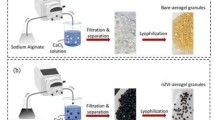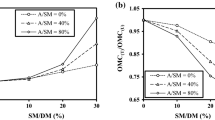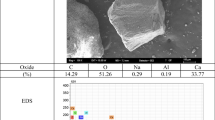Abstract
Drinking water treatment sludge (DWTS) generated from water treatment plants is a global issue because of the environmental risks it imposes. Managing the abundance of DWTS in landfills remains an important issue. The reuse of these sludges as a construction material could contribute to the development of a geopolymer and mitigate the harmful effects of the excessive production of these sludges on the environment. This study aims to evaluate the effect of DWTS on the properties of Class F fly ash (FFA) geopolymers. Seven geopolymer blends were made with the addition of DWTS in the total fly ash weight of 0%, 5%, 10%, 15%, 20%, 30%, and 40%, and with an alkaline solution composed of 12 M sodium hydroxide (NaOH) and sodium silicate (Na2SiO3) solution; the liquid/solid and (Na2SiO3)/NaOH weight ratios were set to 0.75 and 2.5 respectively. The polymerization temperature was set at 60 °C and different polymerization times such as 3, 7, 14, and 28 days were considered. The bulk density, apparent porosity, compressive strength, and microstructure of the geopolymer samples were tested. The experimental results revealed that the optimum percentage of DWTS incorporation is 20 wt%, which generates a dense and homogeneous microstructure. The addition of more than 20% DWTS decreased the compressive strength from 40.87 to 35.3 MPa and bulk density from 2.134 to 2.087 g/cm3 due to the retention of air bubbles and evaporation of water during the polymerization process forming voids in the matrix, which results in increased apparent porosity from 19 to 22%. This investigation confirmed the feasibility of incorporating DWTS into FFA-based geopolymers.
Graphical abstract











Similar content being viewed by others
Data availability
Not applicable.
References
Abbasi SM, Ahmadi H, Khalaj G, Ghasemi B (2016) Microstructure and mechanical properties of a metakaolinite-based geopolymer nanocomposite reinforced with carbon nanotubes. Ceram Int 14:15171–15176. https://doi.org/10.1016/j.ceramint.2016.06.080
Ahmad T, Ahmad K, Alam M (2018) Investigating calcined filter backwash solids as supplementary cementitious material for recycling in construction practices. Constr Build Mater 175:664–671. https://doi.org/10.1016/j.conbuildmat.2018.04.227
Ahmad T, Suryati E, Muliani M (2017) Screening sponges for bacteriocide to be used in shrimp culture. Indones Fish Res J 1:1–10. https://doi.org/10.15578/ifrj.1.1.1995.1-10
Ahmed MM, El-Naggar KAM, Tarek D et al (2021) Fabrication of thermal insulation geopolymer bricks using ferrosilicon slag and alumina waste. Case Stud Constr Mater 15:e00737. https://doi.org/10.1016/j.cscm.2021.e00737
Akkouri N, Baba K, Simou S et al (2020) Recycled thermoplastics modified bitumen improved with thermoplastic elastomer. E3S Web Conf 150:02015. https://doi.org/10.1051/e3sconf/202015002015
Akkouri N, Baba K, Ait Elkassia A (2022a) Valorization of plastic waste (PP-LDPE) from Moroccan industry in modification of hybrid bitumen: application of the mixture design methodology. Int J Pavement Res Technol. https://doi.org/10.1007/s42947-022-00162-1
Akkouri N, Baba K, Simou S et al (2019) The impact of recycled plastic waste in Morocco on bitumen physical and rheological properties. Recent Thoughts Geoenvironmental Eng. https://doi.org/10.1007/978-3-030-34199-2_9
Akkouri N, Bourzik O, Baba K, Nounah A (2022b) Experimental study of the thermal and mechanical properties of concrete incorporating recycled polyethylene. Mater Today Proc 58:1525–1529. https://doi.org/10.1016/j.matpr.2022.03.293
Akkouri N, Oumaima B, Baba K, Tayeh B (2022c) Thermophysical characteristics of eco-friendly mortars containing recycled PET as partial sand replacement in dry and wet conditions. Innov Infrastruct Solut 7:238. https://doi.org/10.1007/s41062-022-00838-4
Al Bakri AM, Kamarudin H, Bnhussain M et al (2012) The processing, characterization, and properties of fly ash based geopolymer concrete. Rev Adv Mater Sci 30:90–97
Alanazi H, Hu J, Kim Y-R (2019) Effect of slag, silica fume, and metakaolin on properties and performance of alkali-activated fly ash cured at ambient temperature. Constr Build Mater 197:747–756. https://doi.org/10.1016/j.conbuildmat.2018.11.172
Almutairi AL, Tayeh BA, Adesina A et al (2021) Potential applications of geopolymer concrete in construction: a review. Case Stud Constr Mater 15:e00733. https://doi.org/10.1016/j.cscm.2021.e00733
Alonso S, Palomo A (2001) Alkaline activation of metakaolin and calcium hydroxide mixtures: influence of temperature, activator concentration and solids ratio. Mater Lett 47:55–62. https://doi.org/10.1016/S0167-577X(00)00212-3
Amin M, Zeyad AM, Tayeh BA, Agwa IS (2021) Effect of high temperatures on mechanical, radiation attenuation and microstructure properties of heavyweight geopolymer concrete. Struct Eng Mech 80:181–199. https://doi.org/10.12989/sem.2021.80.2.181
Antoni WSW, Satria J et al (2016) The use of borax in deterring flash setting of high calcium fly ash based geopolymer. Mater Sci Forum 857:416–420. https://doi.org/10.4028/www.scientific.net/MSF.857.416
Assaedi H, Alomayri T, Kaze CR et al (2020) Characterization and properties of geopolymer nanocomposites with different contents of nano-CaCO3. Constr Build Mater 252:119137. https://doi.org/10.1016/j.conbuildmat.2020.119137
Babatunde AO, Zhao YQ (2007) Constructive approaches toward water treatment works sludge management: an international review of beneficial reuses. Crit Rev Environ Sci Technol 37:129–164. https://doi.org/10.1080/10643380600776239
Barbosa VFF, MacKenzie KJD, Thaumaturgo C (2000) Synthesis and characterisation of materials based on inorganic polymers of alumina and silica: sodium polysialate polymers. Int J Inorg Mater 2:309–317. https://doi.org/10.1016/S1466-6049(00)00041-6
Bohórquez González K, Pacheco E, Guzmán A et al (2020) Use of sludge ash from drinking water treatment plant in hydraulic mortars. Mater Today Commun 23:100930. https://doi.org/10.1016/j.mtcomm.2020.100930
Bourzik O, Akkouri N, Baba K, Nounah A (2022) Study of the effect of wood waste powder on the properties of concrete. Mater Today Proc. https://doi.org/10.1016/j.matpr.2022.02.518
Canımkurbey B (2020) Investigation dielectric and morphological properties of fly ash collected from thermal power plant. Asia-Pac J Chem Eng 15:e2437. https://doi.org/10.1002/apj.2437
da Silva Godinho DDS, Pelisser F, Bernardin AM (2022) High temperature performance of geopolymers as a function of the Si/Al ratio and alkaline media. Mater Lett 311:131625. https://doi.org/10.1016/j.matlet.2021.131625
Davidovits J (2013) Geopolymer cement: a review. Saint-Quentin, France
Davidovits J (1994) Global warming impact on the cement and aggregates industries. World Resour Rev 6:263–278
Davidovits J (2018) Geopolymers based on natural and synthetic metakaolin a critical review. Ceramic Eng Science Proc 38(3):201–214
Fernández-Jiménez A, Palomo A (2005) Mid-Infrared Spectroscopic Studies of Alkali-Activated Fly Ash Structure. Microporous Mesoporous Mater 86:207–214. https://doi.org/10.1016/j.micromeso.2005.05.057
Frías M, Vigil de la Villa R, de Soto I et al (2014) Influence of activated drinking-water treatment waste on binary cement-based composite behavior: characterization and properties. Compos Part B Eng 60:14–20. https://doi.org/10.1016/j.compositesb.2013.12.020
Gouny F, Fouchal F, Maillard P, Rossignol S (2012) A geopolymer mortar for wood and earth structures. Constr Build Mater 36:188–195. https://doi.org/10.1016/j.conbuildmat.2012.04.009
Granizo M, Alonso S, Blanco-Varela M, Palomo A (2004) Alkaline activation of metakaolin: effect of calcium hydroxide in the products of reaction. J Am Ceram Soc 85:225–231. https://doi.org/10.1111/j.1151-2916.2002.tb00070.x
Haddaji Y, Majdoubi H, Mansouri S et al (2020) Effect of sodium hexafluorosilicate addition on the properties of metakaolin based geopolymers cured at ambient temperature. Silicon. https://doi.org/10.1007/s12633-020-00536-9
Hamada HM, Al-attar AA, Yahaya FM et al (2020) Effect of high-volume ultrafine palm oil fuel ash on the engineering and transport properties of concrete. Case Stud Constr Mater 12:e00318. https://doi.org/10.1016/j.cscm.2019.e00318
Hamdane H, Tamraoui Y, Mansouri S et al (2020) Effect of alkali-mixed content and thermally untreated phosphate sludge dosages on some properties of metakaolin based geopolymer material. Mater Chem Phys. https://doi.org/10.1016/J.MATCHEMPHYS.2020.122938
Hidalgo A, Calvo J, Garcia-Olmo J, et al (2008) Microstructural Evolution of Calcium Aluminate Cements Hydration with Silica Fume and Fly Ash Additions by Scanning Electron Microscopy, and Mid and Near‐Infrared Spectroscopy. J Am Ceram Soc 91:1258–1265. https://doi.org/10.1111/j.1551-2916.2008.02283.x
Huseien GF, Mirza J, Ismail M, Hussin MW (2016) Influence of different curing temperatures and alkali activators on properties of GBFS geopolymer mortars containing fly ash and palm-oil fuel ash. Constr Build Mater 125:1229–1240. https://doi.org/10.1016/j.conbuildmat.2016.08.153
Huseien GF, Sam ARM, Mirza J et al (2018) Waste ceramic powder incorporated alkali activated mortars exposed to elevated temperatures: performance evaluation. Constr Build Mater 187:307–317. https://doi.org/10.1016/j.conbuildmat.2018.07.226
Husillos Rodríguez N, Martínez-Ramírez S, Blanco-Varela MT et al (2011) Evaluation of spray-dried sludge from drinking water treatment plants as a prime material for clinker manufacture. Cem Concr Compos 33:267–275. https://doi.org/10.1016/j.cemconcomp.2010.10.020
IPCC (2014) Climate change 2014: synthesis report. In: Core Writing Team, Pachauri RK and Meyer LA (eds.) Contribution of Working Groups I, II and III to the Fifth Assessment Report of the Intergovernmental Panel on Climate Change. IPCC, Geneva, 151 pp.
Kaze RC, Beleuk LM, Djouka MLF, Nana A, Kamseu E, Melo UFC, Leonelli C (2017) Applied Clay Science The corrosion of kaolinite by iron minerals and the effects on geopolymerization. Appl Clay Sci 138:48–62. https://doi.org/10.1016/j.clay.2016.12.040
Kaze RC, Beleuk à Moungam LM, Cannio M et al (2018) Microstructure and engineering properties of Fe2O3(FeO)-Al2O3-SiO2 based geopolymer composites. J Clean Prod 199(849):859. https://doi.org/10.1016/j.jclepro.2018.07.171
Kong DLY, Sanjayan JG (2010) Effect of elevated temperatures on geopolymer paste, mortar and concrete. Cem Concr Res 40:334–339. https://doi.org/10.1016/j.cemconres.2009.10.017
Lecomte I, Henrist C, Liégeois M, et al (2006) (Micro)-structural comparison between geopolymers, alkali-activated slag cement and Portland cement. J Eur Ceram Soc 16:3789–3797. https://doi.org/10.1016/j.jeurceramsoc.2005.12.021
Li Y, Min X, Ke Y et al (2019) Preparation of red mud-based geopolymer materials from MSWI fly ash and red mud by mechanical activation. Waste Manag 83:202–208. https://doi.org/10.1016/j.wasman.2018.11.019
Li D, Zhuge Y, Liu Y et al (2021) Reuse of drinking water treatment sludge in mortar as substitutions of both fly ash and sand based on two treatment methods. Constr Build Mater 277:122330. https://doi.org/10.1016/j.conbuildmat.2021.122330
Liew AG, Idris A, Wong CHK et al (2004) Incorporation of sewage sludge in clay brick and its characterization. Waste Manag Res 22:226–233. https://doi.org/10.1177/0734242X04044989
Liu Y, Zhuge Y, Chow CWK et al (2020) Utilization of drinking water treatment sludge in concrete paving blocks: microstructural analysis, durability and leaching properties. J Environ Manage 262:110352. https://doi.org/10.1016/j.jenvman.2020.110352
Mimboe AG, Abo MT, Djobo JNY et al (2020) Lateritic soil based-compressed earth bricks stabilized with phosphate binder. J Build Eng 31:101465. https://doi.org/10.1016/j.jobe.2020.101465
Nimwinya E, Arjharn W, Horpibulsuk S et al (2016) A sustainable calcined water treatment sludge and rice husk ash geopolymer. J Clean Prod 119:128–134. https://doi.org/10.1016/j.jclepro.2016.01.060
Okuda T, Nishijima W, Sugimoto M et al (2014) Removal of coagulant aluminum from water treatment residuals by acid. Water Res 60:75–81. https://doi.org/10.1016/j.watres.2014.04.041
Ooi TY, Yong EL, Din MFM et al (2018) Optimization of aluminium recovery from water treatment sludge using response surface methodology. J Environ Manage 228:13–19. https://doi.org/10.1016/j.jenvman.2018.09.008
Petermann J, Saeed A, Hammons M (2010) Alkali-activated geopolymers: a literature review. Report AFRL-RX-TY-TR-2010-0097. Air Force Research Laboratory, Florida.
Poowancum A, Nimwinya E, Horpibulsuk S (2015) Development of room temperature curing geopolymer from calcined water-treatment-sludge and rice husk ash. In: Scrivener K, Favier A (eds) Calcined clays for sustainable concrete. Springer, Netherlands, pp 291–297
Qaidi SMA, Tayeh BA, Isleem HF et al (2022) Sustainable utilization of red mud waste (bauxite residue) and slag for the production of geopolymer composites: a review. Case Stud Constr Mater 16:e00994. https://doi.org/10.1016/j.cscm.2022.e00994
Ramadan MO, Fouad HA, Hassanain AM (2008) Reuse of water treatment plant sludge in brick manufacturing. J Appl Sci Res 4:1223–1229
Rodrigue Kaze C, Adesina A, Laure Lecomte-Nana G et al (2021a) Synergetic effect of rice husk ash and quartz sand on microstructural and physical properties of laterite clay based geopolymer. J Build Eng 43:103229. https://doi.org/10.1016/j.jobe.2021.103229
Rodrigue Kaze C, Ninla Lemougna P, Alomayri T et al (2021b) Characterization and performance evaluation of laterite based geopolymer binder cured at different temperatures. Constr Build Mater 270:121443. https://doi.org/10.1016/j.conbuildmat.2020.121443
Rodrigues LP, Holanda JNF (2015) Recycling of water treatment plant waste for production of soil-cement bricks. Procedia Mater Sci 8:197–202. https://doi.org/10.1016/j.mspro.2015.04.064
Saif MS, El-Hariri MOR, Sarie-Eldin AI et al (2022) Impact of Ca+ content and curing condition on durability performance of metakaolin-based geopolymer mortars. Case Stud Constr Mater 16:e00922. https://doi.org/10.1016/j.cscm.2022.e00922
Shadnia R, Zhang L (2017) Experimental study of geopolymer synthesized with Class F fly ash and low-calcium slag. J Mater Civ Eng 29:04017195. https://doi.org/10.1061/(ASCE)MT.1943-5533.0002065
Si R, Guo S, Dai Q, Wang J (2020) Atomic-structure, microstructure and mechanical properties of glass powder modified metakaolin-based geopolymer. Constr Build Mater 254:119303. https://doi.org/10.1016/j.conbuildmat.2020.119303
Singh J, Singh S (2019) Development of Alkali-activated cementitious material using copper slag. Constr Build Mater 211:73–79. https://doi.org/10.1016/j.conbuildmat.2019.03.233
Sore SO, Messan A, Prud’homme E et al (2016) Synthesis and characterization of geopolymer binders based on local materials from Burkina Faso – metakaolin and rice husk ash. Constr Build Mater 124:301–311. https://doi.org/10.1016/j.conbuildmat.2016.07.102
Standard A (2005) C20 standard test methods for apparent porosity, water absorption, apparent specific gravity, and bulk density of burned refractory brick and shapes by boiling water. ASTM International, West Conshohocken
Taher SMS, Saadullah ST, Haido JH, Tayeh BA (2021) Behavior of geopolymer concrete deep beams containing waste aggregate of glass and limestone as a partial replacement of natural sand. Case Stud Constr Mater 15:e00744. https://doi.org/10.1016/j.cscm.2021.e00744
Tayeh BA, Zeyad AM, Agwa IS, Amin M (2021) Effect of elevated temperatures on mechanical properties of lightweight geopolymer concrete. Case Stud Constr Mater 15:e00673. https://doi.org/10.1016/j.cscm.2021.e00673
Tayeh BA, Hakamy A, Amin M et al (2022) Effect of air agent on mechanical properties and microstructure of lightweight geopolymer concrete under high temperature. Case Stud Constr Mater 16:e00951. https://doi.org/10.1016/j.cscm.2022.e00951
Teixeira SR, Santos GTA, Souza AE et al (2011) The effect of incorporation of a Brazilian water treatment plant sludge on the properties of ceramic materials. Appl Clay Sci 53:561–565. https://doi.org/10.1016/j.clay.2011.05.004
Tho-In T, Sata V, Boonserm K, Chindaprasirt P (2018) Compressive strength and microstructure analysis of geopolymer paste using waste glass powder and fly ash. J Clean Prod 172:2892–2898. https://doi.org/10.1016/j.jclepro.2017.11.125
Topark-Ngarm P, Chindaprasirt P, Sata V (2015) Setting time, strength, and bond of high-calcium fly ash geopolymer concrete. J Mater Civ Eng 27:04014198. https://doi.org/10.1061/(ASCE)MT.1943-5533.0001157
Waijarean N, Asavapisit S, Sombatsompop K (2014) Strength and microstructure of water treatment residue-based geopolymers containing heavy metals. Constr Build Mater 50:486–491. https://doi.org/10.1016/j.conbuildmat.2013.08.047
Wang H, Wu H, Xing Z et al (2021) The effect of various Si/Al, Na/Al molar ratios and free water on micromorphology and macro-strength of metakaolin-based geopolymer. Materials 14:3845. https://doi.org/10.3390/ma14143845
Xiao R, Ma Y, Jiang X et al (2020) Strength, microstructure, efflorescence behavior and environmental impacts of waste glass geopolymers cured at ambient temperature. J Clean Prod 252:119610. https://doi.org/10.1016/j.jclepro.2019.119610
Yaseri S, Hajiaghaei G, Mohammadi F et al (2017) The role of synthesis parameters on the workability, setting and strength properties of binary binder based geopolymer paste. Constr Build Mater 157:534–545. https://doi.org/10.1016/j.conbuildmat.2017.09.102
Yaseri S, Verki VM, Mahdikhani M (2019) Utilization of high volume cement kiln dust and rice husk ash in the production of sustainable geopolymer. J Clean Prod. https://doi.org/10.1016/J.JCLEPRO.2019.05.056
Yu P, Kirkpatrick RJ, Poe B et al (2004) Structure of calcium silicate hydrate (C-S-H): near-, mid-, and far-infrared spectroscopy. J Am Ceram Soc 82:742–748. https://doi.org/10.1111/j.1151-2916.1999.tb01826.x
Zeyad AM, Magbool HM, Tayeh BA et al (2022) Production of geopolymer concrete by utilizing volcanic pumice dust. Case Stud Constr Mater 16:e00802. https://doi.org/10.1016/j.cscm.2021.e00802
Zhang Y, Xiao R, Jiang X et al (2020) Effect of particle size and curing temperature on mechanical and microstructural properties of waste glass-slag-based and waste glass-fly ash-based geopolymers. J Clean Prod 273:122970. https://doi.org/10.1016/j.jclepro.2020.122970
Acknowledgements
The authors would like to thank the “National Office of Electricity and Drinking Water” (ONEE) for supplying the drinking water sludge, and to acknowledge the support of the “National Center for Scientific and Technical Research” (CNRST) under the research excellence award program
Author information
Authors and Affiliations
Contributions
OB: conceptualization, methodology, investigation, formal analysis, visualization, and writing — original draft, writing — review and editing. NA: methodology, writing — review and editing. YH: methodology, writing — review and editing. KB: supervision, resources, writing — review and editing. AN: resources, writing — review and editing. MA: resources, writing — review and editing. KB: resources, writing — review and editing.
Corresponding author
Ethics declarations
Ethics approval and consent to participate
Not applicable.
Consent for publication
Not applicable.
Competing interests
The authors declare no competing interests.
Additional information
Responsible Editor: Philippe Garrigues
Publisher's note
Springer Nature remains neutral with regard to jurisdictional claims in published maps and institutional affiliations.
Rights and permissions
About this article
Cite this article
Bourzik, O., Akkouri, N., Baba, K. et al. Study of the effects of drinking water treatment sludge on the properties of Class F fly ash-based geopolymer. Environ Sci Pollut Res 29, 87668–87679 (2022). https://doi.org/10.1007/s11356-022-21873-9
Received:
Accepted:
Published:
Issue Date:
DOI: https://doi.org/10.1007/s11356-022-21873-9




